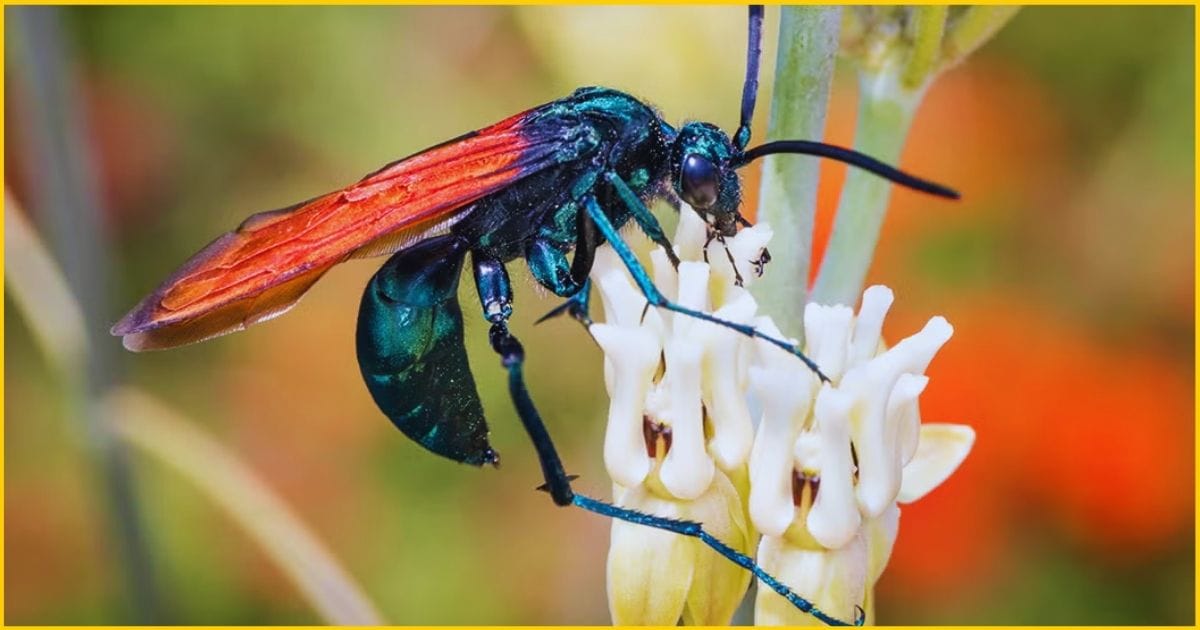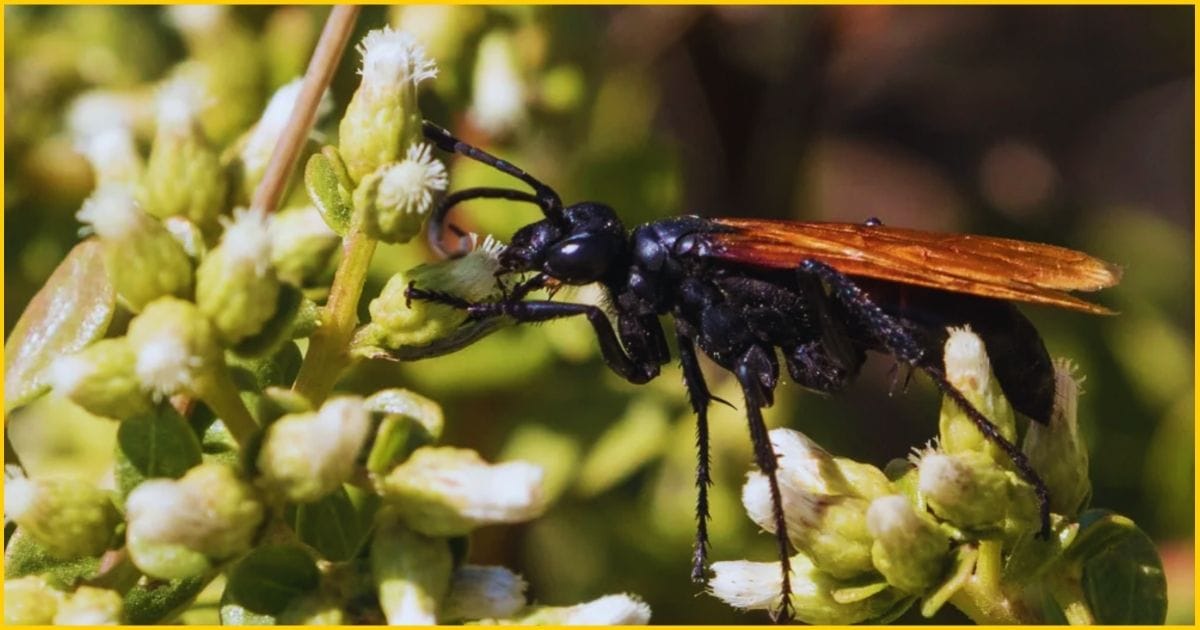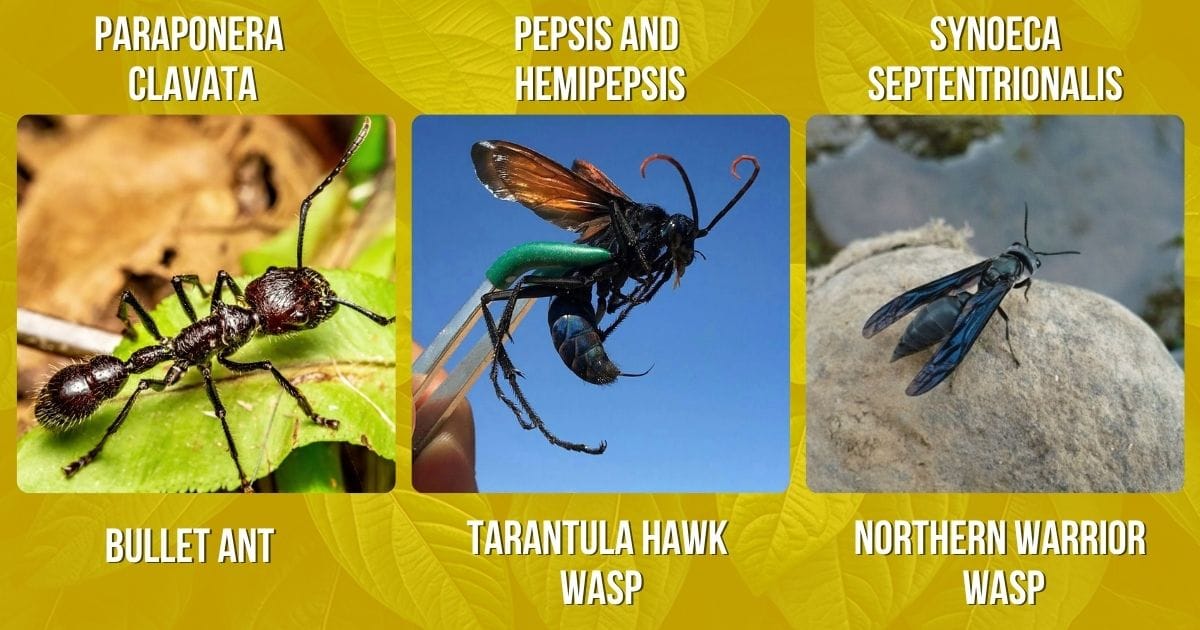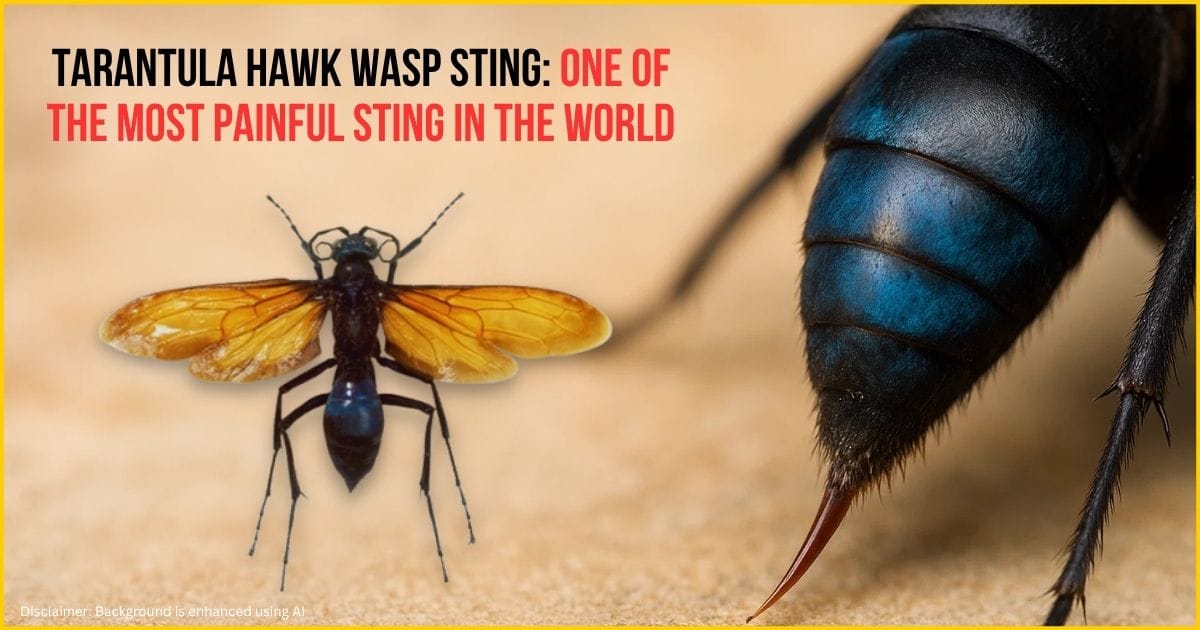The tarantula hawk wasp is one of the most powerful and painful insects in nature. Tarantula Hawk Wasp Sting one of the most painful stings in the insect world. These spider wasps, which belong to the Pepsis and Hemipepsis groups, are amazing specialized hunters. They go after their prey, mostly tarantulas, which are much bigger than them, and use their very painful sting as both a weapon and protection.
Table of Contents
- Meet Spider Wasp
- What is Tarantula Hawk?
- Physical Characteristics and Identification
- Distribution and Habitat
- Behavior and Lifecycle
- How Bad is a Tarantula Hawk Wasp Sting?
- The Schmidt Pain Index Rating
- Tarantula Hawk Wasp Sting Intensity and Duration
- Comparative Pain Analysis
- Tarantula Hawk Wasp Sting Symptoms
- Immediate Physical Symptoms
- Localized Reactions
- Systemic Responses
- Duration and Recovery
- Tarantula Hawk Wasp Sting Treatment
- Immediate Emergency Response
- Pain Management Strategies
- Wound Care and Hygiene
- Amazing Facts About Tarantula Hawk Wasp Sting
- Conclusion
Meet Spider Wasp
Spider wasps belong to the Pompilidae family and are one of the most diverse and specialized types of parasitic wasps. These unique insects are expert spider hunters. Most species focus on hunting specific kinds of spiders. While there are many types of spider wasps, the most well-known are the tarantula hawks from the Pepsis and Hemipepsis groups.

Spider wasps have some clear physical characteristics that make them easy to identify. They usually have large heads with strong eyes that help them spot prey, long spiny legs for grabbing spiders, and a powerful stinger at the end of their abdomen. Many also have bright warning colors, called aposematic coloration, which lets predators know they are dangerous.
These wasps are impressive hunters. They can find, attack, and paralyze spiders with their venomous sting. This venom makes the spider unable to move, so the wasp can carry it to a nest. There, the wasp lays an egg on the spider’s body, which will later be food for the baby wasp.
What is Tarantula Hawk?

Tarantula hawks are not birds or a type of tarantula spider, even though their name might make you think so. They are actually large spider wasps from the Pepsis and Hemipepsis groups in the Pompilidae family. These wasps are among the biggest parasitic wasps in the world. One species, Pepsis heros, can grow as long as 11 centimeters (about 4 inches). More commonly seen species, like Pepsis grossa and Pepsis thisbe, are usually around 5 centimeters (2 inches) long
Physical Characteristics and Identification
Tarantula hawks have unique physical features that make them easy to recognize. Their bodies are usually steel blue or blue-black, often with a shiny, colorful look that can appear blue-green or blue-violet depending on the light. Most of them have bright orange, amber, or rust-colored wings, although some have black wings with blue highlights. These bright colors act as a warning to predators, showing that the wasps can defend themselves with a very painful sting.
They have long, thin bodies and spiny legs with hooked claws that help them grab and hold spiders. Female tarantula hawks can be identified by their curled antennae, while males have straight ones. Only females have stingers, and in some species like Pepsis grossa, the stinger can be as long as 12 millimeters (about 15/32 of an inch).
Distribution and Habitat
Tarantula hawks are found in many parts of the world and live on every continent except Europe and Antarctica. They are especially common in the southwestern United States, Central America, and South America. In North America, six different species are known to live in Colorado alone, each with its own range across the region.
These wasps live in many types of environments, such as desert scrublands, grasslands, and rainforests, actually anywhere tarantulas are found. They prefer places with loose, sandy soil where they can dig burrows and open spaces that make it easier to hunt their prey.
Behavior and Lifecycle

Adult tarantula hawks mostly feed on nectar from flowers. They are often seen visiting plants like milkweeds, western soapberry trees, and mesquite. Because of this, they play an important role in pollination, especially for milkweed plants, which are vital for monarch butterflies.
Tarantula hawks go through a full life cycle, including four stages: egg, larva, pupa, and adult. After mating, the female starts hunting tarantulas to use as living hosts for her young. It usually takes several weeks for a tarantula hawk to grow from an egg into an adult. The larva stage lasts about three weeks, followed by a pupal stage that takes another 2 to 3 weeks.
How Bad is a Tarantula Hawk Wasp Sting?
The sting of the tarantula hawk wasp is famous for being one of the most painful insect stings in the world. It has received the highest rating, level 4 on the Schmidt Sting Pain Index, a scientific scale created by entomologist Justin Schmidt. He described the pain as “blinding, fierce, shockingly electric.” One vivid comparison says the sting feels like “a running hair dryer that has just been dropped in your bubble bath.”
The Schmidt Pain Index Rating
On Schmidt’s carefully designed pain scale, which goes from 1 to 4, the tarantula hawk wasp (Pepsis grossa) holds the top level 4 alongside only one other insect: the bullet ant (Paraponera clavata). However, while the bullet ant’s sting can cause pain that lasts for 12 hours or more, the pain from a tarantula hawk sting is extremely intense but much shorter, usually lasting only 3 to 5 minutes.
Schmidt described the sting as immediate and overwhelming. Research shows that the pain can be so intense that it causes people to lose control of their movements and thinking. This can lead to accidents like falling or bumping into things. Scientific studies even suggest that the best thing to do after being stung is to “lie down and scream” until the pain goes away.
Tarantula Hawk Wasp Sting Intensity and Duration
The pain from a tarantula hawk sting is often described as “instantaneous, electrifying, excruciating, and totally debilitating.” Several researchers who have experienced the sting report that it causes an immediate loss of both speech and muscle coordination. The pain hits its peak within seconds and slowly fades over the next three to five minutes
In one well-known case, researcher Howard Evans was stung several times while trying to collect tarantula hawks with a net. The pain became so unbearable that he crawled into a ditch and cried until the sting’s effects passed. Stories like this highlight just how powerful and disabling the sting can be, even for experienced entomologists who are used to handling stinging insects.
Comparative Pain Analysis

To understand how painful a tarantula hawk sting is, it’s useful to compare it to other insect stings. On the Schmidt Sting Pain Index, most common bee and wasp stings are rated at level 2. In contrast, the tarantula hawk’s sting is rated at level 4 (the highest level) meaning its pain is many times worse. Only two other insects share this top rating: the bullet ant and the Synoeca septentrionalis wasp.
What makes the tarantula hawk’s sting so unique is its venom. It causes a type of pain that feels very different from other stings. While a bee sting might feel like a burn and a yellow jacket sting might throb, the tarantula hawk sting is described as feeling like a powerful electric shock that completely overwhelms your nervous system.
Tarantula Hawk Wasp Sting Symptoms
The symptoms that follow a tarantula hawk wasp sting are both immediate and extremely intense. They cause a unique set of physical reactions that make these stings very different from most other insect stings. Understanding these symptoms is important for anyone who might come across these wasps in the wild.
Immediate Physical Symptoms
The most noticeable symptom right after a tarantula hawk sting is the intense pain that starts within seconds. This pain is often described as electric, burning, and completely disabling. Unlike most insect stings that cause a local throbbing or burning feeling, a tarantula hawk sting creates shock, like waves of pain that spread out from the sting area.
Because the pain is so strong, victims often lose control of their body movements and their ability to think clearly. This reaction makes it very hard to walk, speak, or even stay upright. The pain can be so overwhelming that people may scream, fall down, or move uncontrollably without meaning to.
Localized Reactions
At the sting site, victims usually show the typical signs of inflammation seen with most stings from bees and wasps. These include quick swelling, redness, and warmth in the area. However, during the first few minutes, the extreme pain often makes these symptoms less noticeable.
You may also see a small puncture mark where the stinger penetrates into the skin, and sometimes there may be a little bleeding. Once the intense pain fades, the area usually becomes sore and may stay sensitive to touch for several hours after the sting.
Systemic Responses
Although the pain is focused around the sting site, the body often reacts in a much broader way due to the extreme intensity and can produce systemic effects. Victims commonly experience a rapid heartbeat, high blood pressure, and heavy sweating as part of the body’s natural stress response to severe pain. Some people also feel dizzy or lightheaded, especially if they try to stand or move around during the worst moments.
The sting can also have a strong psychological effect. Many people describe feeling panic or fear while the pain is at its peak. This reaction is understandable, as most people have never felt anything as intense, making the experience both physically and mentally overwhelming.
Duration and Recovery
The most intense phase of symptoms usually lasts for about 3 to 5 minutes. During this time, the pain slowly changes from a sharp, electric-shock feeling to a more bearable throbbing or burning sensation. Most people say that after around five minutes, the pain becomes mild enough that they can move normally and think clearly again.
Recovery after a tarantula hawk sting is usually quick once the worst pain is over. Unlike some insect stings that can cause long-term problems, tarantula hawk stings rarely leave lasting effects. The only after-effects are usually mild swelling and tenderness at the sting site. This fast recovery and short duration of symptoms show that the venom is mainly meant to scare off threats, not to cause long-term harm.
Tarantula Hawk Wasp Sting Treatment
Treatment for a tarantula hawk wasp sting mainly focuses on managing the intense pain and providing supportive care. Although the sting is extremely painful, the venom is not usually dangerous to humans. The goal of treatment is to help the person get through the worst of the pain and to prevent any other problems that might happen during the most intense phase.
Immediate Emergency Response
The first thing to do when someone is stung by a tarantula hawk is to make sure they are safe. Because the pain is extremely strong, the person should be moved to a safe place, away from any danger. Experts suggest that the person should lie down right away to avoid falling or getting hurt while in pain.
While the sting is still very painful, it’s important to watch for signs of a serious allergic reaction. Although this is rare with tarantula hawk stings, symptoms like trouble breathing, swelling all over the body, fast heartbeat, or fainting are serious and need emergency medical help immediately.
Pain Management Strategies
Because the pain is very strong, regular painkillers you buy at the store may not help much at first. However, medicines like ibuprofen can help reduce pain and swelling once the worst part of the pain is over. In very painful cases, especially if someone is stung more than once, stronger painkillers like opioids might be used, as suggested by some medical reports.
Using ice can also help. It numbs the area and brings down swelling. You should wrap some ice in a thin cloth and place it on the sting for 10 minutes at a time. Do not put ice directly on the skin, as it can cause frostbite.
Wound Care and Hygiene
Good wound care starts by washing the sting area well with soap and water. This helps remove bacteria or any leftover venom on the skin. Cleaning also helps stop other infections that could slow down healing.
Tarantula hawk wasps are different from bees because they don’t leave their stingers behind, so you don’t need to remove anything. After the sting, keep an eye on the area for a few days. Watch for signs of infection like more redness, heat, swelling, or pus.
Amazing Facts About Tarantula Hawk Wasp Sting
Evolutionary Purpose
- Extreme pain serves as defensive mechanism, not offensive weapon
- Creates overwhelmingly negative experience for predators to remember
- Strategy called aposematic defense enhanced by bright warning colors
- Provides “near absolute protection from vertebrate predators”
- Combines visual warnings, behavioral displays, and painful sting backup
Venom Composition
- Complex mixture designed for both offensive and defensive purposes
- Contains angiotensin-converting enzyme (ACE) – first time found in solitary wasp venom
- Includes hyaluronidase (“spreading factor”) for rapid tissue distribution
- Contains pompilidotoxins (PMTXs) – neurotoxic peptides targeting arthropod nervous systems
- Enzymes involved in arthropod metabolism and classical toxins
Defensive Mechanisms
- Bright coloration serves as primary warning signal visible from distances
- Distinctive buzzing sounds with wings
- Emit specific chemical odors alerting predators
- Jerky flight patterns and bold behavioral displays
- Multi-layered approach prevents most aggressive encounters
Prey Paralysis
- Same venom causes complete paralysis in spiders lasting 2 hours to 2 months
- Keeps spider alive but immobile for developing wasp larvae
- Spider maintains functioning internal organs but cannot move
- Precision allows wasps to paralyze spiders many times their size
- Remarkable biological adaptation for extended fresh food supply
Scientific Applications
- Potential applications in developing new analgesics or anesthetics
- Causes primarily pain rather than tissue damage in vertebrates
- Pompilidotoxins useful as research tools for studying nervous system function
- Offers insights into evolutionary adaptations and neural system differences
- Specificity for arthropod vs vertebrate nervous systems scientifically valuable
Natural Predators
- Roadrunners use quick strikes to kill wasps before stinging
- Bullfrogs swallow them whole with large tongues
- Effectiveness leads to mimicry by other insects
- Robber fly (Wyliea mydas) evolved similar coloration and stinging motions
- Few predators have evolved strategies to overcome defenses
Human Encounters
- Remarkably docile toward humans and rarely sting unless handled
- Most encounters involve accidental contact
- Wasps typically attempt to escape rather than attack
- Brief pain duration with no lasting effects
- Beneficial role as pollinators recognized over pest classification
Ecological Impact
- Important pollinators in their ecosystems
- Control spider populations naturally
- Serve as model for defensive mimicry in other species
- Part of complex predator-prey relationships
- Contribute to biodiversity and ecological balance
Conclusion
The tarantula hawk wasp sting stands as one of nature’s most remarkable examples of evolutionary adaptation, combining extreme pain delivery with biological precision to create an unparalleled defensive mechanism. When people ask “how bad is the tarantula hawk wasp sting,” the answer consistently points to one of the most intense pain experiences in the natural world. These impressive insects have earned their notorious reputation through delivering what scientists rank as a maximum level 4 on the Schmidt Sting Pain Index, making the tarantula hawk sting legendary among entomologists and pain researchers alike.
